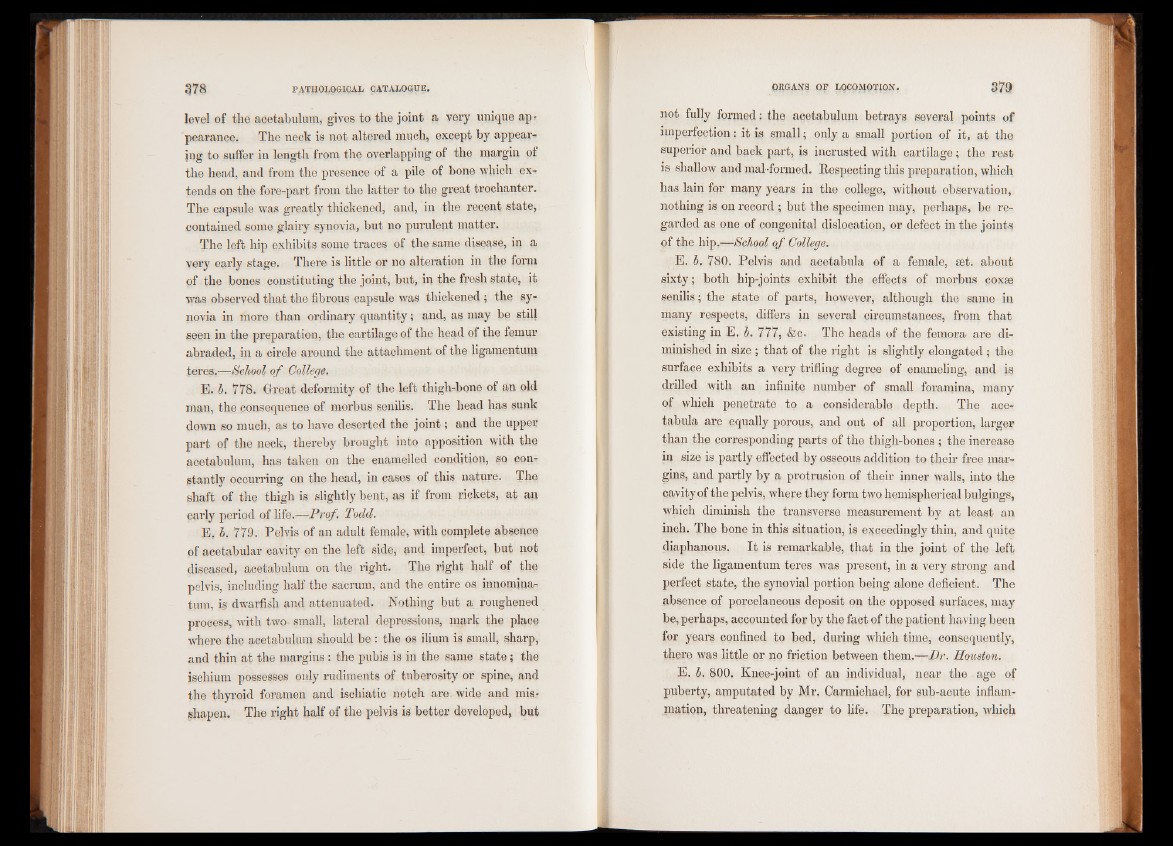
level of the acetabulum, gives to the joint a very unique appearance.
The neck is not altered much, except by appearing
to suffer in length from the overlapping of the margin pf
the head, and from the presence of a pile of bone which extends
on the fore-part from the latter to the great trochanter.
The capsule was greatly thickened, and, in the regent state,
contained some glairy synovia, but no purulent matter.
The left hip exhibits some traces of the same disease, in a
very early stage. There is little or no alteration in the form
of the bones constituting the joint, but, in the fresh state, it
was observed that the fibrous capsule was thickened; the synovia
in more than ordinary quantity; and, as may be still
seen in the preparation, the cartilage of the head of the femur
abraded, in a circle around the attachment of the ligamentum
teres.—=-School of College.
E. b. 778. Great deformity of the left thigh-bone of an old
man, the consequence of morbus senilis. The head has sunk
down so much, as to have deserted the joint; and the upper
part of the neck, thereby brought into apposition with the
acetabulum, has taken on the enamelled condition, so constantly
occurring on the head, in cases of this nature. The
shaft of the thigh is slightly bent, as if from rickets, at an
early period of life.-—Prof. Todd,.
E. b. 779. Pelvis of an adult female, with complete absence
of acetabular cavity on the left side, and imperfect, but not
diseased, acetabulum on the right. The right half of the
pelvis, including half the sacrum, and the entire os innomina-
tum, i§ dwarfish and attenuated. Nothing but a roughened
process, with two small, lateral depressions, mark the place
where the acetabulum should be : the os ilium is small, sharp,
and thin at the margins : the pubis is in the same state 5 the
ischium possesses only rudiments of tuberosity or spine, and
the thyroid foramen and ischiatic noteh are, wide and misshapen.
The right half of the pelvis is better developed, hut
not fully formed: the acetabulum betrays several points of
imperfection: it is small; only a small portion of it, at the
superior and back part, is incrusted with cartilage; the rest
is shallow and mal -formed. Respecting this preparation, which
has lain for many years in the college, without observation,
nothing is on record ; but the specimen may, perhaps, be regarded
as one of congenital dislocation, or defect in the joints
of the hip.—School of College.
E. b, 780. Pelvis and acetabula of a female, set. about
sixty; both hip-joints exhibit the effects of morbus coxse
senilis; the state of parts, however, although the same in
many respects, differs in several circumstances, from that
existing in E, b. 777, &c. The heads of the femora are diminished
in size ; that of the right is slightly elongated; the
surface exhibits a very trifling degree of enameling, and is
drilled with an infinite number of small foramina, many
of which penetrate to a considerable depth. The ace-,
tabula are equally porous, and out of all proportion, larger
than the corresponding parts of the thigh-bones ; the increase
in size is partly effected by osseous addition to their free margins,
and partly by a protrusion of their inner walls, into the
cavity of the pelvis, where they form two hemispherical bulgings,
which diminish the transverse measurement by at least an
inch. The bone in this situation, is exceedingly thin, and quite
diaphanous. It is remarkable, that in the joint of the left
side the ligamentum teres was present, in a very strong and
perfect state, the synovial portion being alone deficient. The
absence of porcelaneous deposit on the opposed surfaces, may
be, perhaps, accounted for by the fact of the patient having been
for years confined to bed, during which time, consequently,
there was little or no friction between them.—Dr. Houston.
E. b. 800. Knee-joint of an individual, near the age of
puberty, amputated by Mr. Carmichael, for sub-acute inflammation,
threatening danger to life. The preparation, which